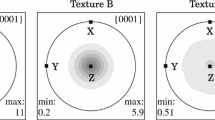Abstract
Twinning is an important deformation mechanism in hexagonal close-packed (hcp) metals such as Mg, Zr, Ti, and Be. Twinning in hcp materials is a multiscale process that depends on microstructural and mechanical response details at the mesoscale, microscale, and atomic scales. Twinning can generally be understood as a two-step process, a nucleation step followed by propagation. The nucleation of twins is governed by both material details such as the defect configurations at potential nucleation sites within grain boundaries, as well as the highly local mechanical field near grain boundaries. These two factors, the material and mechanical, must align for a successful nucleation event. In this article, we present a stochastic constitutive law for nucleation of twins and describe its implementation into a homogenized crystal plasticity simulation. Twin nucleation relies on the dissociation of grain boundary defects under stress into the required twinning partials. This dissociation is considered to follow a Poisson process where the parameters of the Poisson distribution are related to the properties of the grain boundaries. The rate of the process is a direct function of the local stress concentration at the grain boundary. These stress concentrations are randomly sampled from a distribution calibrated to full-field crystal plasticity simulations.







Similar content being viewed by others
References
I. Beyerlein, J. Wang, M. Barnett, and C. Tomé, Proc. R. Soc. A 468, 1496 (2012).
I. Beyerlein and C. Tomé, Proc. R. Soc. A 466, 2517 (2010).
J. Wang and I. Beyerlein, Model. Simul. Mater. Sci. 20, 024002 (2012).
I. Beyerlein, R. McCabe, and C. Tomé, J. Mech. Phys. Solids 59, 988 (2011).
A. Khosravani, D. Fullwood, J. Scott, M. Miles, and R. Mishra, Acta Mater. in press (2012).
A. Bhattacharyya, E. El-Danaf, S. Kalidindi, and R. Doherty, Int. J. Plast. 17, 861 (2001).
D. Mika and P. Dawson, Mater. Sci. Eng. A, 257, 62 (1998).
F. Roters, P. Eisenlohr, L. Hantcherli, D. Tjahjanto, T. Bieler, and D. Raabe, Acta Mater. 58, 1152 (2010).
A. Kanjarla, L. Delannay, and P. Van Houtte, Metall. Mater. Trans. A 42, 660 (2011).
H. Moulinec and P. Suquet, Comput. Method Appl. Mech. Eng. 157, 69 (1998).
R.A. Lebensohn, Acta Mater. 49, 2723 (2001).
R. Lebensohn, A. Rollett, and P. Suquet, JOM 63 (3), 13 (2011).
R. Lebensohn and C. Tomé, Acta Metall. Mater. 41, 2611 (1993).
G. Proust, C. Tomé, and G. Kaschner, Acta Mater. 55, 2137 (2007).
A. Salem, S. Kalidindi, and S. Semiatin, Acta Mater. 53, 3495 (2005).
L. Capolungo, P. Marshall, R. McCabe, I. Beyerlein, and C. Tomé, Acta Mater. 57, 6047 (2009).
I. Beyerlein, L. Capolungo, P. Marshall, R. McCabe, and C. Tomé, Philos. Mag. A 90, 2161 (2010).
J. Wang, R. Hoagland, J. Hirth, L. Capolungo, I. Beyerlein, and C. Tomé, Scr. Mater. 61, 903 (2009).
S. Mendelson, J. Appl. Phys. 41, 1893 (1970).
M. Yoo and J. Lee, Philos. Mag. A 63, 987 (1991).
L. Capolungo and I. Beyerlein, Phys. Rev. B 78, 024117 (2008).
D. Cox and V. Isham, Point Processes (Boca Raton, FL: Chapman & Hall/CRC Press, 1980).
R. Lebensohn, A. Kanjarla, and P. Eisenlohr, Int. J. Plast. 32–33, 59 (2011).
A. Kanjarla, R. Lebensohn, L. Balogh, and C. Tomé, Acta Mater. 60, 3094 (2012).
R. Lebensohn, C. Tomé, and P. Castaneda, Philos. Mag. 87, 4287 (2007).
I. Beyerlein and C. Tomé, Int. J. Plast. 24, 867 (2008).
A. Thorvaldsen, J. Appl. Phys. 73, 7831 (1993).
DREAM.3D, version 4 (Springboro, OH: BlueQuartz Software and U.S. Air Force Research Laboratory, 2012).
Acknowledgements
The authors acknowledge full support from the U.S. Department of Energy (DOE), Office of Science, Basic Energy Science, Project FWP 06SCPE401 and Project 20110602ER. Los Alamos National Laboratory is operated by LANS, LLC, for the National Nuclear Security Administration of the U.S. DOE under Contract DE-AC52-06NA25396.
Author information
Authors and Affiliations
Corresponding author
Rights and permissions
About this article
Cite this article
Niezgoda, S.R., Beyerlein, I.J., Kanjarla, A.K. et al. Introducing Grain Boundary Influenced Stochastic Effects into Constitutive Models. JOM 65, 419–430 (2013). https://doi.org/10.1007/s11837-012-0550-7
Received:
Accepted:
Published:
Issue Date:
DOI: https://doi.org/10.1007/s11837-012-0550-7



